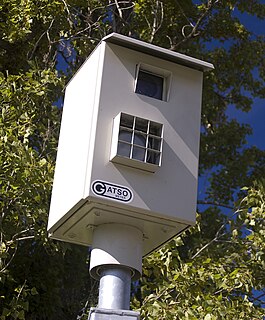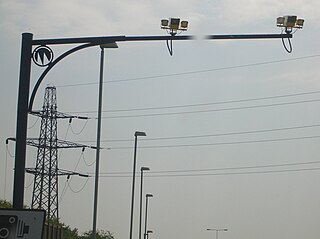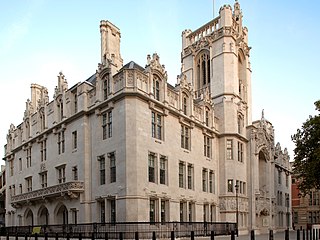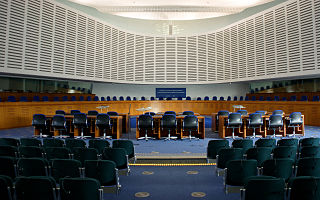Related Research Articles

The European Convention on Human Rights is an international convention to protect human rights and political freedoms in Europe. Drafted in 1950 by the then newly formed Council of Europe, the convention entered into force on 3 September 1953. All Council of Europe member states are party to the Convention and new members are expected to ratify the convention at the earliest opportunity.

Speed limits on road traffic, as used in most countries, set the legal maximum speed at which vehicles may travel on a given stretch of road. Speed limits are generally indicated on a traffic sign reflecting the maximum permitted speed - expressed as kilometres per hour (km/h) and/or miles per hour (mph). Speed limits are commonly set by the legislative bodies of national or provincial governments and enforced by national or regional police and judicial authorities. Speed limits may also be variable, or in some places nonexistent, such as on most of the Autobahnen in Germany.

Newburgh Heights is a village in Cuyahoga County, Ohio, United States. The population was 2,167 at the 2010 census.

A traffic enforcement camera is a camera which may be mounted beside or over a road or installed in an enforcement vehicle to detect motoring offenses, including speeding, vehicles going through a red traffic light, vehicles going through a toll booth without paying, unauthorized use of a bus lane, or for recording vehicles inside a congestion charge area. It may be linked to an automated ticketing system.

A traffic ticket is a notice issued by a law enforcement official to a motorist or other road user, indicating that the user has violated traffic laws. Traffic tickets generally come in two forms, citing a moving violation, such as exceeding the speed limit, or a non-moving violation, such as a parking violation, with the ticket also being referred to as a parking citation, or parking ticket.

A red light camera is a type of traffic enforcement camera that photographs a vehicle that has entered an intersection after the traffic signal controlling the intersection has turned red. By automatically photographing vehicles that run red lights, the photo is evidence that assists authorities in their enforcement of traffic laws. Generally the camera is triggered when a vehicle enters the intersection after the traffic signal has turned red.
Many countries have adopted a penalty point or demerit point system under which a person’s driving license is cancelled or suspended based on the number of points accumulated by them over a period of time because of the traffic offences or infringements committed by them in that period. The demerit points schemes of each jurisdiction varies. These demerit schemes are usually in addition to fines or other penalties which may be imposed for a particular offence or infringement, or after a prescribed number of points have been accumulated.
The European Convention of Human Rights Act 2003 is an act of the Irish parliament, the Oireachtas, which gave further effect to the European Convention on Human Rights in Irish law. It is substantially similar to the UK's Human Rights Act 1998.
Nick Freeman is an English solicitor best known as a celebrity defence lawyer, specialising in traffic and speeding offences. He is the owner of Manchester-based legal practice Freeman & Co.
Brendlin v. California, 551 U.S. 249 (2007), was a decision by the Supreme Court of the United States that held that all occupants of a car are "seized" for purposes of the Fourth Amendment during a traffic stop, not just the driver.
Driving in the United Kingdom is governed by various legal powers and in some cases is subject to the passing of a driving test. The government produces a Highway Code that details the requirements for all road users, including drivers. Unlike most other countries in the world, UK traffic drives on the left.

An advisory speed limit is a speed recommendation by a governing body, used when it may be non-obvious to the driver that the safe speed is below the legal speed. It is a posting which either approximates the Basic Speed Law or rule or is based on a maximum g-force exerted at a specific speed. Advisory speed limits are often set in areas with many pedestrians, such as in city centres and outside schools, and on difficult stretches of roads, such as on tight corners or through roadworks. While travelling above the advisory speed limit is not illegal per se, it may be negligence per se and liability for any collisions that occur as a result of traveling above the limit can be placed partially or entirely on the person exceeding the advisory speed limit.
Intelligent speed assistance (ISA), or intelligent speed adaptation, also known as alerting, and intelligent authority, is any system that ensures that vehicle speed does not exceed a safe or legally enforced speed. In case of potential speeding, a human driver can be alerted, or the speed reduced automatically.
The right to silence in England and Wales is the protection given to a person during criminal proceedings from adverse consequences of remaining silent. It is sometimes referred to as the privilege against self-incrimination. It is used on any occasion when it is considered the person(s) being spoken to is under suspicion of having committed one or more criminal offences and consequently thus potentially being subject to criminal proceedings.

Speed limits are enforced on most public roadways by authorities, with the purpose to improve driver compliance with speed limits. Methods used include roadside speed traps set up and operated by the police and automated roadside 'speed camera' systems, which may incorporate the use of an automatic number plate recognition system. Traditionally, police officers used stopwatches to measure the time taken for a vehicle to cover a known distance. More recently, radar guns and automated in-vehicle systems have come into use.

Road speed limit enforcement in the United Kingdom is the action taken by appropriately empowered authorities to attempt to persuade road vehicle users to comply with the speed limits in force on the UK's roads. Methods used include those for detection and prosecution of contraventions such as roadside fixed speed cameras, average speed cameras, and police-operated LIDAR speed guns or older radar speed guns. Vehicle activated signs and Community Speed Watch schemes are used to encourage compliance. Some classes of vehicles are fitted with speed limiters and intelligent speed adaptation is being trialled in some places on a voluntary basis.

Cadder v HM Advocate [2010] UKSC 43 is a decision in which the Supreme Court of the United Kingdom held that the way in which police in Scotland detained suspects was not compatible with the European Convention on Human Rights and was therefore unlawful in terms of the Scotland Act 1998.

Carson and Others v. The United Kingdom [2010] ECHR 338 was heard by the European Court of Human Rights (ECHR), in Strasbourg on 16 March 2010 on appeal from the European Court of Rights (ECHR), Fourth Section before Jean-Paul Costa (President), Christos Rozakis, Nicolas Bratza, Peer Lorenzen, Françoise Tulkens, Josep Casadevall, Karel Jungwiert, Nina Vajić, Dean Spielmann, Renate Jaeger, Danutė Jočienė, Ineta Ziemele, Isabelle Berro-Lefèvre, Päivi Hirvelä, Luis López Guerra, Mirjana Lazarova Trajkovska, Zdravka Kalaydjieva.

MJELR v Rettinger[2010] IESC 45, [2010] 3 IR 783, was a case in which the Irish Supreme Court ruled that to resist the application of a European Arrest Warrant on the basis that it would result in treatment contrary to Article 3 of the European Convention on Human Rights (ECHR), the wanted individual must offer substantial grounds to believe that he or she would be exposed to a real risk of such treatment.
Slovenian Disability Rights Association is a disability rights organization in Slovenia. Its goals are to enhance the implementation of the Convention on the Rights of Persons with Disabilities and to assist persons with disabilities through awareness raising and impact litigation. Drupis was founded in 2012.
References
- ↑ "O'Halloran & Francis v. UK European Court of Human Rights". Motor Defence Solicitors. 2007-06-29. Retrieved 2022-01-11.
- 1 2 3 4 5 6 "O'HALLORAN AND FRANCIS - 15809/02 [2007] ECHR 545 (29 June 2007)". Bailii.org. Retrieved 2022-01-11.
- 1 2 "Drivers lose speed camera test case in Strasbourg court". The Guardian. 2007-06-30. Retrieved 2022-01-11.
- ↑ "Motorists lose speed camera case". BBC News. 2007-06-29. Retrieved 2022-01-11.
- 1 2 "No right to silence in speeding cases". Irish Independent. Retrieved 2022-01-11.
- ↑ "Speed camera pair lose final appeal". Reuters. 29 June 2007.
- ↑ "Speeding drivers lose appeal to human rights court". The Guardian. 2007-06-29. Retrieved 2022-01-11.
- ↑ Birdling, Malcolm (2008). "Self-Incrimination Goes to Strasbourg: O'Halloran and Francis v United Kingdom". The International Journal of Evidence & Proof. 12: 58–63. doi:10.1350/ijep.2008.12.1.287. S2CID 147291245.
- 1 2 "O'HALLORAN AND FRANCIS - 15809/02 [2007] ECHR 544 (29 June 2007)". Bailii.org. Retrieved 2022-01-11.